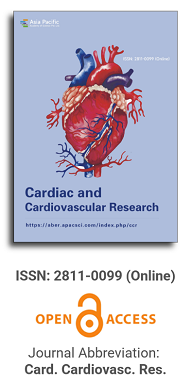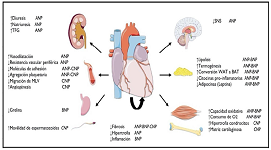
Asia Pacific Academy of Science Pte. Ltd. (APACSCI) specializes in international journal publishing. APACSCI adopts the open access publishing model and provides an important communication bridge for academic groups whose interest fields include engineering, technology, medicine, computer, mathematics, agriculture and forestry, and environment.

This issue's research highlight is the role of long non-coding RNA (lncRNA) in cardiovascular diseases. Research shows that lncRNA is closely linked to various cardiovascular conditions and has potential as a biomarker.
Issue release: 31 December 2023
Diabetes mellitus is one of the main causes of morbidity and mortality worldwide. This group of patients generally represents a population at high or very high cardiovascular risk, which is why early risk stratification is performed, seeking to focus objectively on the pharmacological and nonpharmacological approach with an intensive strategy. Cardiovascular disease represents the main cause of mortality, but in recent years there have been advances in therapeutics that have been shown to reduce major cardiovascular events. This article reviews the interaction between diabetes, cardiovascular disease and its treatment.
Issue release: 31 December 2023
Objective: The cardiac muscle cannot be anatomically free in the thorax and without a support to fulfill its hemodynamic function. Therefore, the possibility of the existence of a support point acting as a lever was analyzed. Material and methods: We used: 1) cardiac dissection in ten young bovine hearts [800-1000 g]; 2) cardiac dissection in eight human hearts: one embryo of 23 weeks gestation; one 10 year old, 250 g; and six adults, mean weight 300 g. The myocardial band was unwound completely. The myocardial band was uncoiled in its entirety. The extracted pieces were analyzed for anatomy and histology. The investigation was completed with simple radiographic imaging studies, magnetic resonance imaging and computed tomography. Results: In anatomical investigations we have found in all human and bovine hearts studied a nucleus underlying the right trigone of bone-chondroid-tendinous histological structure. Microscopic analysis revealed in bovine hearts a trabecular osteochondral matrix [fulcrum]. In all human hearts the fulcrum was found to be formed by chondroid tissue. In this structure, not described by other authors, the origin and end of the myocardial fibers have muscular insertion. Imaging techniques confirmed its existence. Conclusions: The cardiac fulcrum found in the anatomical investigation of human and bovine hearts would clarify about the necessary fulcrum of the myocardial muscle to complete its twisting movements.
Issue release: 31 December 2023
Historically, the heart has been considered a vital organ due to its function as an impeller and aspirating blood pump, allowing the fi siological perfusion to every corner of the human body. However, behind this pump role lies a little-discussed function, that is, the endocrine-metabolic role of the heart, as a hormone synthesizing organ and, because of its pump function, a distributor of hormones foreign to it. Understanding the incidence of peptides synthesized in the heart offers a new perspective on the relevance of the heart in homeostasis and how cardiovascular disease can alter metabolism. The present work aims to review the most current information on the role of natriuretic peptides produced in the heart and their endocrine-metabolic function. These are atrial, brain and C-type natriuretic peptides. It is concluded that the conception of the heart as an organ of endocrine-metabolic regulation, whose hormones are essential for the homeostasis of the organism, is fundamental for the medicine of this century and for future advances in new therapeutic strategies to improve the quality of life of patients.
Issue release: 31 December 2023
Long non coding RNA (lncrna) is a highly conserved non coding RNA (ncRNA) with a length of more than 200 nucleotides. Studies have found that lncrna is closely related to transcriptional regulation, post transcriptional regulation and apparent regulation, and thus participates in the regulation of cardiovascular physiology and pathophysiology. This article summarizes the current biological characteristics of circulating lncrna, the value of lncrna as a potential biomarker of cardiovascular diseases and the future prospects of therapeutic methods.
Issue release: 31 December 2023
Objective: To investigate the effect of obstructive sleep apnea hypopnea syndrome (OSAHS) on cardiac autonomic nervous homeostasis. Methods the patients with OSAHS diagnosed in our hospital were the observation group, and the non OSAHS patients in the same period were the control group. The differences of baseline data, sleep monitoring, time domain analysis index of heart rate variability, peripheral blood methoxyepinephrine (MN) and methoxynorepinephrine (NMN) between the two groups were analyzed. The observation group was divided into light, medium and heavy groups according to apnea index (AHI), and the correlation analysis between age, AHI, lsao2, time domain index and blood catecholamine metabolites was carried out. Results: Ahi was negatively correlated with SDNN and PNN50% (P <0.01) and positively correlated with NMN (p<0.05); lsao2 was positively correlated with SDNN and PNN50% (P <0.05), and negatively correlated with vanillic acid 2 (p<0.05). Conclusion patients with OSAHS have obvious disturbance of cardiac sympathetic and vagus nerve balance at night.
Issue release: 31 December 2023
Objectives: Cocaine is regularly utilized topically to give the vasoconstriction to nasal medical procedure; However, it is said to create intraoperative cardiovascular unfriendly impacts. Methylphenidate was considered in the place of cocaine as a substitute to look at the vasoconstriction in nasal medical procedure. Methods: Outcome of the study will be examining the vasoconstriction based on a 5-point scale (1 = unacceptable, 5 = excellent), followed by the administration of either 20–30 mg per day methylphenidate or 4% cocaine randomly to the adult patients subjected to nasal septoplasty. Results: Methylphenidate and cocaine were administered with 38 and 28 patients respectively. The quality of vasoconstriction was noticed to be good in both the groups with the median rating of 4.0 and a P value of 0.85. With both the gatherings, the median blood loss was 46 and 58 ml with a p estimation of 0.48. A non-mediocrity delta of 1 point with a p estimation of 0.009 and non-inadequacy delta of 24 ml with a p esteem 0.026 concerning vasoconstriction and blood loss individually is seen which demonstrates methylphenidate is comparable to cocaine. Non importance is noted with the recurrence of ventricular ectopy, ST section changes after nasal packing with the gatherings. Conclusions: With the results obtained, methylphenidate can be very well replaced for cocaine for vasoconstriction in septoplasty. As there are lot many underlying chances for cocaine abuse and administrative issues related to its handling, methylphenidate may serve as a substitute.

Prof. Prakash Deedwania
University of California,
San Francisco, United States





 Open Access
Open Access